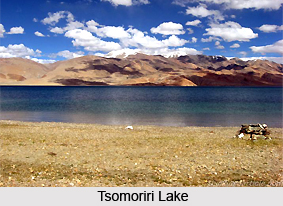 Tsomoriri Wetland Conservation Reserve, also known as Tsomoriri or Lake Moriri, is located in the Changthang area in Ladakh. This is a High Altitude Lake (HAL) with an altitude of 4,595 m (15,080 ft) in Ladakh, and is the largest of the High Altitude Lakes in the Trans-Himalayan biogeographic region. The melted snow of the surrounding snow covered mountains is the source of water that flow into the Changthang basin.
Tsomoriri Wetland Conservation Reserve, also known as Tsomoriri or Lake Moriri, is located in the Changthang area in Ladakh. This is a High Altitude Lake (HAL) with an altitude of 4,595 m (15,080 ft) in Ladakh, and is the largest of the High Altitude Lakes in the Trans-Himalayan biogeographic region. The melted snow of the surrounding snow covered mountains is the source of water that flow into the Changthang basin.
According to the classification of the Himalayan Lakes done on the basis of their origin, there are four groups and Tsomoriri falls under the third group of "Remnant Lakes". They are glacial lakes, Structural lakes, Remnant lakes and Natural dammed lakes. The Glacial lakes are formed in and around glaciers whereas Structural lakes are formed by folds or faults due to movements in earth`s crust. Remnant lakes were originally geomorphologic but represent the remnants of vast lakes and the Natural dammed lakes result from the deposition of rocks along the river courses. The basin of the lake is also categorized as an endorheic basin as it is a closed drainage basin that holds water and does not allow any outflow to other bodies of water like rivers or oceans. This lake is hemmed in by the elevated valley of Rupshu.
Tsomoriri Wetland Conservation Reserve is the house of some avifauna and flora like the Tibetan Ass, thirty-four species of birds included 14 species of water birds, Black-necked Cranes (Grus nigricollis), Bar-headed Geese (Anser indicus), Brown-headed Gulls (Larus brunnicephalus), Great Crested Grebe (Podiceps cristatus), Ferruginous Pochard, Black-necked Grebe Podiceps nigricollis, Tibetan gazelle, Procapra picticaudata, Goa antelope, Ovis ammon hogdsoni (Argali), Lynx etc. Some mammalian faunas are also observed in this territory like Nayan Ovis ammon hodgsoni, Bharal (Pseudois nayaurr) Himalayan blue sheep, Tibetan Ass (Kiang) or Equus kiang, one species of marmot- Marmota himalayana, One species of hare- Lepus oistolus, One species of vole- Alticola roylei, three species of mouse hares, Ochotona macrotis, Ochotona curzoniae or Tibetan Sand Fox and Scincella ladacensis. Including these, large carnivores like the Snow Leopard (Uncia uncial), the Tibetan Grey Wolf (Canilupus chanku) are also seen. Even Tsomoriri is the most important breeding locality for the Waterfowl in Ladakh. The lake is the abode of Barheaded Geese Anser Indicus and Podiceps Cristatus, Todorns ferrugines, Charadrius mongolus, lerus brannicephalus, Sterna hirundo, etc.
Though there is no abundance of vegetation in the lake, but different species of sedges and reeds grow in the adjoining areas among which some are Carex, Caragana, and Astragelus apps. Moreover, several species of Carex, Primula (low growing herb), and Pedicularis (parasite plant) and common species of Juncus thomsonii and Leontopodium sp, Phytoplankton species of Oocystis and diatom Cyclotella are also observed.
Tsomoriri Wetland Conservation Reserve is the abode of different species of floras and faunas and this lake serves as a breeding land for these animals and plants.



















